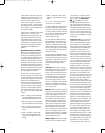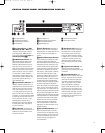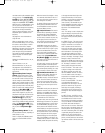
22
› Composite and S-V
ideo Monitor
Outputs:
If you are not using the
CVPD50, or if you desire a secondary dis-
play, connect thse jacks to the composite
or S-video input of a TV monitor or video
projector to view the output of any stan-
dard video source selected by the receiv-
er’s video switcher. If both standard com-
posite and S-video sources are used,
you must make connections from both
Video Monitor Output jacks to your
display. Also, if component video sources
are used, you must also connect the
Component V
ideo Monitor Output
·
to the display.
NOTE: The CVR700 is optimized to be
used with the CVPD50 High-Definition
Plasma Display. Composite, S-video and
component video monitor outputs on the
CVR700 are provided as a means of con-
necting an auxiliary display only. On-
screen status messages, and all digital
video post-processing – including scaling,
de-interlacing, and upconversion features
of the CVR700 – are only available when
used with CVPD50.
fiRemote IR Output: This connection
permits the IR sensor in the receiver to
serve other remote controlled devices.
Connect this jack to the “IR IN” jack on
JBL (or other compatible) equipment.
fl Remote IR Input: If the CVR700’s
front-panel IR sensor is blocked due to cab-
inet doors or other obstructions, an exter-
nal IR sensor may be used. Connect the
output of the sensor to this jack.
NOTE: The remote IR input and output on
the CVR700 are only used for non-video
functions, and will have no effect on the
CVPD50 plasma display. JBL recommends
that you point the remote control at the
LED light on the front of the CVPD50 dis-
play for all functions, as the CVPD50 will
pass any non-video command codes to
the CVR700.
‡ Component V
ideo Digital
Recorder Inputs:
These inputs may
be used with any video source device
equipped with analog Y/Pr/Pb component
video outputs. These jacks are perma-
nently linked to the Digital Recorder
Source input.
° Component Video Cable/Satellite
Inputs:
These inputs may be used with
any video source device equipped with
analog Y/Pr/Pb component video out-
puts. These jacks are permanently linked
to the Cable/Satellite source input.
· Component V
ideo Monitor
Outputs:
If you are not using the
CVPD50, or if you desire a secondary
video display, connect these outputs to
the component video inputs of a video
projector or monitor. When a source con-
nected to one of the
Component Video
Inputs
‡° is selected, the signal will
be sent to these jacks.
NOTE: The CVR700 is optimized to be
used with the CVPD50 High-Definition
Plasma Display. Composite, S-video and
component video monitor outputs on the
CVR700 are provided as a means of con-
necting an auxiliary display only. On-
screen status messages, and all digital
video post-processing – including scaling,
de-interlacing, and upconversion features
of the CVR700 – are only available when
used with CVPD50.
a Picture-in-Picture (PIP)
Composite Video Input:
Connect the
composite video output of a video device
that you would like to have available for
picture-in-picture (PIP) viewing using the
JBL Cinema Vision CVPD50 screen. When
the PIP function is activated, the signal
fed to this jack will appear within a small
field over the main program visible on
the plasma screen. Except for the DVI/
Computer source, the PIP view may also
be available as a split screen. Use the
Screen menu system to configure the PIP
view. When the main source is HD com
-
ponent video (480p or better), the PIP
function is not available.
The PIP source must be able to output
composite video simultaneously with
its main method of connection to the
CVR700. If the PIP device is connected
via its composite video output to a source
input on the CVR700, a Y-Cable will be
required to connect to both the main
source input jack and the PIP input.
b Coaxial Digital Audio Output:
Connect this jack to the coaxial digital
input of a DVD+R/RW, DVD-R/RW, CD-
R/RW
, MiniDisc or other compatible
digital recorder.
c Auxiliary Coaxial Digital Audio
Input:
Connect the coax digital output
from a DVD player, HDTV receiver, the
S/P-DIF output of a compatible computer
sound card playing audio files or streams,
LD player or CD player to this jack. The
signal may be a Dolby Digital signal, DTS
signal or a standard PCM digital source.
Do not connect the RF digital output of
an LD player to this jack. This input is
permanently assigned to the Auxiliary
source input.
d Cable/Satellite Coaxial Digital
Audio Input:
Connect the coaxial digital
audio output from a DVD player, HDTV
receiver
, the S/P-DIF output of a compati-
ble computer sound card playing audio
files or streams, LD player or CD player
to this jack. The signal may be a Dolby
Digital signal, DTS signal or a standard
PCM digital source. Do not connect the
RF digital output of an LD player to this
jack. This input is permanently assigned
to the Cable/Satellite source input.
e DVI/Computer Coaxial Digital
Audio Input:
Connect the coaxial digital
audio output from a DVD player, HDTV
receiver, the S/P-DIF output of a compati-
ble computer sound card playing audio
files or streams, LD player or CD player
to this jack. The signal may be a Dolby
Digital signal, DTS signal or a standard
PCM digital source. Do not connect the
RF digital output of an LD player to this
jack. This input is permanently assigned
to the DVI/Computer source input.
f Digital Recorder Coaxial Digital
Audio Input:
Connect the coaxial digital
audio output from a DVD player, HDTV
receiver, the S/P-DIF output of a compati-
ble computer sound card playing audio
files or streams, LD player or CD player
to this jack. The signal may be a Dolby
Digital signal, DTS signal or a standard
PCM digital source. Do not connect the
RF digital output of an LD player to this
jack. This input is permanently assigned
to the Digital Recorder source input.
g Optical Digital Audio Output:
Connect this jack to the optical digital
input connector on a DVD+R/RW, DVD-
R/RW
, CD-R/RW, MiniDisc or other com-
patible digital recorder.
h Auxiliary Optical Digital Audio
Inputs:
Connect the optical digital output
from a DVD player, HDTV receiver, the
S/P-DIF output of a compatible computer
sound card playing audio files or streams,
LD player or CD player to these jacks.
The signal may be a Dolby Digital signal,
a DTS signal or standard PCM digital
source. This input is permanently
assigned to the Auxiliary source input.
i Cable/Satellite Optical Digital
Audio Input:
Connect the optical digital
audio output from a DVD player, HDTV
receiver, the S/P-DIF output of a compati-
ble computer sound card playing audio
files or streams, LD player or CD player
CVR700 OM 12/17/04 4:23 PM Page 22


















